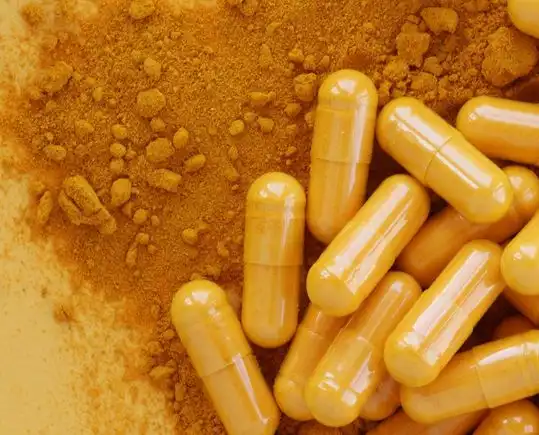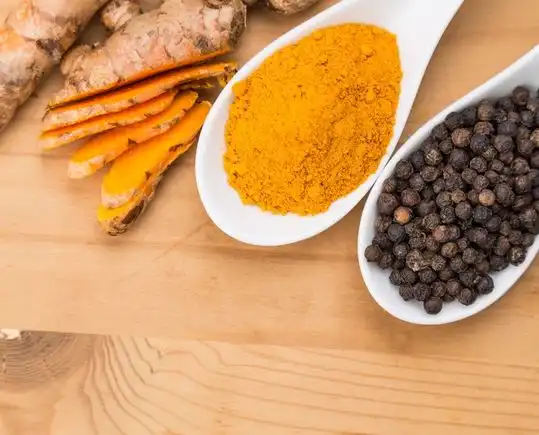Save Some Cash By Spicing Things Up
A Bit About Turmeric
Looking for a way to get more mileage out of your kratom powder? Want to reduce the number of capsules you have to take? Want to do it with an ingredient that you may already be familiar with from your kitchen cabinet? If so, you may want to take a look at combining turmeric and kratom for more pronounced effects.
Among the various combinations, turmeric and kratom make one of the best pairs for those trying to get more for less. The key element is a chemical called curcumin. It is a major component of turmeric and the key to its magic.
Turmeric, or Curcuma longa, is a member of the ginger family and its powder form is often sold in grocery stores somewhere along the spice aisle. It turns foods a yellowish color and is popular in South Asian and Middle Eastern cuisine.
It is also used for medicinal purposes and has a role in Ayurvedic medicine. In India, it is used to treat some stomach issues, improve liver problems, and to help sores heal. Other documented uses include treatment of anorexia, cough, diabetic wounds, sprains and strains, rheumatoid arthritis, and several more.
It is also a notable antioxidant. One study found that curcumin reduced free radicals in the blood by 86-92% while reducing linoleic acid peroxidation by 80%. You can think of free radicals in the body like rust on a piece of metal. These are the things that make you visibly age, among other things.

The more you can reduce oxidation, the better your long-term health. What we are interested in today is the ability to increase the body’s response to kratom. It just so happens turmeric can do that too and in a potent way.
Naturally and safely, at that. Kratom potentiators, like curcumin, make our kratom stronger so we can spend less money on it. You also won’t have to swallow so many capsules or choke down so much powder. Let’s get to a little bit of science.
Turmeric and Kratom Equals Synergy
At the center of turmeric’s health promoting power are bioactive chemical compounds called curcuminoids. This group consists of curcumin, demethoxycurcumin, and bisdemethoxycurcumin. These are actually the parts of the spice that give turmeric its golden-yellow color and are a main driver behind its anti-inflammatory properties.
They are also what makes kratom stronger when consumed alongside it. One of the ways this happens is through the inhibition of the P450 human cytochromes (carrier molecules), or more specifically, an enzyme called CYP3A4.
This enzyme is essentially responsible for clearing kratom out of the system once it reaches the bloodstream. It is also responsible for most of the body’s metabolization of kratom’s alkaloids. Curcumin has also been shown to inhibit the P450 enzymes CYP2B6 and CYP2C9.
The CYP2B6 and CYP2C9 enzymes are responsible for about 10% of kratom’s metabolism. These are the channels through which mitragynine, 7-hydroxymitragynine, and the rest of kratom’s alkaloids take effect.
With activity of CYP3A4 repressed through curcumin consumption, kratom’s alkaloids are not metabolized as quickly. This means there is more circulating in the system and it takes longer to clear. This translates to a stronger and longer lasting experience.

Another area in which turmeric shows strength is as a monoamine oxidase inhibitor (MAOI). Monoamine oxidase enzymes are present in all of us and are responsible for the breakdown of amine transmitters like dopamine, serotonin, epinephrine, and norepinephrine.
These are the chemicals that give rise to things like euphoria, satiety, energy, and focus. Since turmeric acts as an inhibitor to monoamine oxidase, it can cause an increase in the intensity of many of kratom’s effects. This can help the feeling last longer as well. As a side bonus, curcumin has shown supportive effects relating to blood sugar, total cholesterol, lipid peroxides, and good cholesterol.
In one human study, total cholesterol and lipid peroxides were reduced by 11.63% and 33%, respectively, while HDL, or “good” cholesterol was increased by 29%. This was achieved on a daily dosage of 650 mg for one week. That’s not the only time results like this were discovered.
An older study found that rats who were fed cholesterol and curcumin had about half as much free cholesterol and about one-third as much total cholesterol relative to rats who were fed the cholesterol only. The group also showed significant decreases in β-lipoprotein levels.
One thing you have to account for is the fact that turmeric’s chemicals are not extremely bioavailable when consumed orally, meaning you don’t really absorb much of what you consume. Luckily there are ways to actually potentiate this as well. Piperine is an alkaloid found in black pepper and has the ability to boost bioavailability of curcumin by up to 2000%.
Thankfully, many curcumin products contain piperine or black pepper as an absorption enhancer. You want to try to to use about 5 mg of piperine to every 650 mg of standardized curcumin. Look for a product from a trustworthy brand and be sure its standardized for the ingredients you’re looking for (curcuminoids and piperine in this case).

There is a huge difference between ground up turmeric root and a standardized extract, so be careful on this one to avoid wasting your money. Consumer Reports ran some independent tests of turmeric supplements and provides a list of trustworthy supplements on their website.
Turmeric Dosage
As far as dosages go, there have been multitudes of studies that have tested out dosages ranging from 650 mg daily to over 12,000 mg per day. No significant adverse events took place in any published studies at these dosages.
Search Reddit for “turmeric and kratom” to see anecdotal reports from other kratom users. That said, 650 mg has shown to produce clinically significant improvements in important biomarkers (see above). It is unclear whether using more than that is actually beneficial, so using more may simply be a waste for some people.
Most curcumin supplements come in capsule form, but you can mix powdered curcumin rhizomes just fine with kratom powder. Some even choose to mix their turmeric and kratom together.
Conclusion
To conclude, combining turmeric and kratom is a relatively inexpensive method that you can use to increase the strength and effect duration of your kratom. It is one of the best potentiators. Multiple studies have also demonstrated its power as an antioxidant and monoamine oxidase inhibitor.
If you are looking for a way to consume less kratom or simply get more out of the kratom powder or capsules you already consume, look no further than turmeric. It is advisable to use a lower dosage when potentiating with curcumin for obvious reasons.


Latest from our blog
Please Read….This is Urgent
In loving memory of Ryan, a special individual who recently passed away, we honor his [...]
Damiana Exposed: Special Look At Turnera diffusa (2023)
Damiana Exposed: Special Look At Turnera diffusa (2023) Damiana is a wild shrub native to [...]
Kanna: A New Look At An Exciting Mood Booster (2023)
What is kanna? Some say the botanical has similar effects to MDMA, or ecstasy. Others [...]
Blue Lotus Flower: Unveiling Its Mystical & Therapeutic Powers
To cut to the chase and pickup potent 25x blue lotus extract today while enjoying [...]
Red Bubble Kratom Extraction: A Comprehensive Guide
As a kratom enthusiast, have you ever wondered if there was a method for getting [...]
Aug
Maeng Da Kratom 101: Accurate Info You Can Trust
Maeng Da kratom may be the most popular kratom strain on the market today. The [...]
Aug